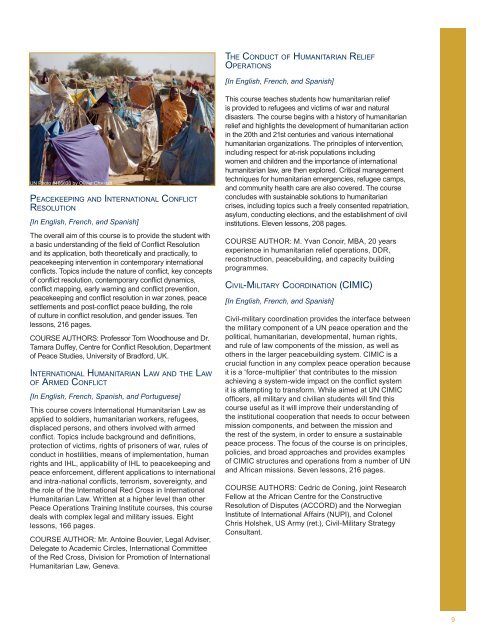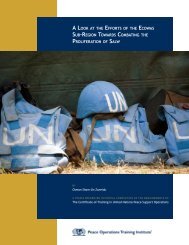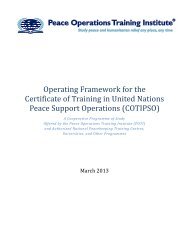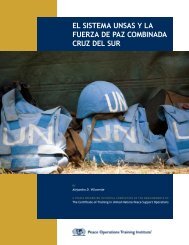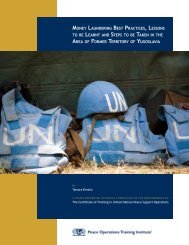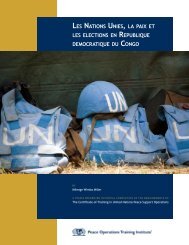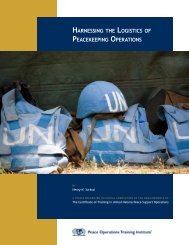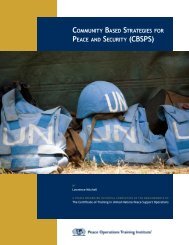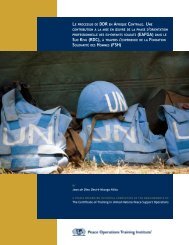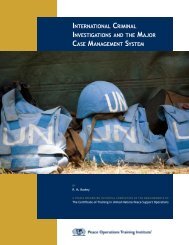Download - Peace Operations Training Institute
Download - Peace Operations Training Institute
Download - Peace Operations Training Institute
You also want an ePaper? Increase the reach of your titles
YUMPU automatically turns print PDFs into web optimized ePapers that Google loves.
The Conduct of Humanitarian Relief<strong>Operations</strong>[In English, French, and Spanish]UN Photo #466633 by Olivier Chassot<strong>Peace</strong>keeping and International ConflictResolution[In English, French, and Spanish]The overall aim of this course is to provide the student witha basic understanding of the field of Conflict Resolutionand its application, both theoretically and practically, topeacekeeping intervention in contemporary internationalconflicts. Topics include the nature of conflict, key conceptsof conflict resolution, contemporary conflict dynamics,conflict mapping, early warning and conflict prevention,peacekeeping and conflict resolution in war zones, peacesettlements and post-conflict peace building, the roleof culture in conflict resolution, and gender issues. Tenlessons, 216 pages.COURSE AUTHORS: Professor Tom Woodhouse and Dr.Tamara Duffey, Centre for Conflict Resolution, Departmentof <strong>Peace</strong> Studies, University of Bradford, UK.International Humanitarian Law and the Lawof Armed Conflict[In English, French, Spanish, and Portuguese]This course covers International Humanitarian Law asapplied to soldiers, humanitarian workers, refugees,displaced persons, and others involved with armedconflict. Topics include background and definitions,protection of victims, rights of prisoners of war, rules ofconduct in hostilities, means of implementation, humanrights and IHL, applicability of IHL to peacekeeping andpeace enforcement, different applications to internationaland intra-national conflicts, terrorism, sovereignty, andthe role of the International Red Cross in InternationalHumanitarian Law. Written at a higher level than other<strong>Peace</strong> <strong>Operations</strong> <strong>Training</strong> <strong>Institute</strong> courses, this coursedeals with complex legal and military issues. Eightlessons, 166 pages.COURSE AUTHOR: Mr. Antoine Bouvier, Legal Adviser,Delegate to Academic Circles, International Committeeof the Red Cross, Division for Promotion of InternationalHumanitarian Law, Geneva.This course teaches students how humanitarian reliefis provided to refugees and victims of war and naturaldisasters. The course begins with a history of humanitarianrelief and highlights the development of humanitarian actionin the 20th and 21st centuries and various internationalhumanitarian organizations. The principles of intervention,including respect for at-risk populations includingwomen and children and the importance of internationalhumanitarian law, are then explored. Critical managementtechniques for humanitarian emergencies, refugee camps,and community health care are also covered. The courseconcludes with sustainable solutions to humanitariancrises, including topics such a freely consented repatriation,asylum, conducting elections, and the establishment of civilinstitutions. Eleven lessons, 208 pages.COURSE AUTHOR: M. Yvan Conoir, MBA, 20 yearsexperience in humanitarian relief operations, DDR,reconstruction, peacebuilding, and capacity buildingprogrammes.Civil-Military Coordination (CIMIC)[In English, French, and Spanish]Civil-military coordination provides the interface betweenthe military component of a UN peace operation and thepolitical, humanitarian, developmental, human rights,and rule of law components of the mission, as well asothers in the larger peacebuilding system. CIMIC is acrucial function in any complex peace operation becauseit is a ‘force-multiplier’ that contributes to the missionachieving a system-wide impact on the conflict systemit is attempting to transform. While aimed at UN CIMICofficers, all military and civilian students will find thiscourse useful as it will improve their understanding ofthe institutional cooperation that needs to occur betweenmission components, and between the mission andthe rest of the system, in order to ensure a sustainablepeace process. The focus of the course is on principles,policies, and broad approaches and provides examplesof CIMIC structures and operations from a number of UNand African missions. Seven lessons, 216 pages.COURSE AUTHORS: Cedric de Coning, joint ResearchFellow at the African Centre for the ConstructiveResolution of Disputes (ACCORD) and the Norwegian<strong>Institute</strong> of International Affairs (NUPI), and ColonelChris Holshek, US Army (ret.), Civil-Military StrategyConsultant.9


